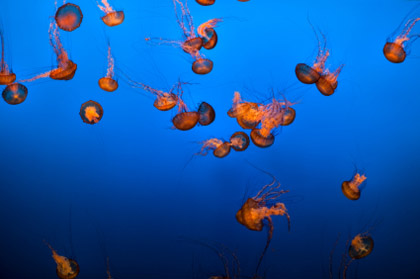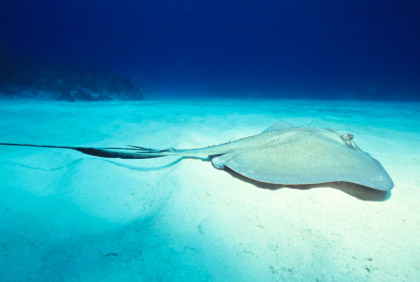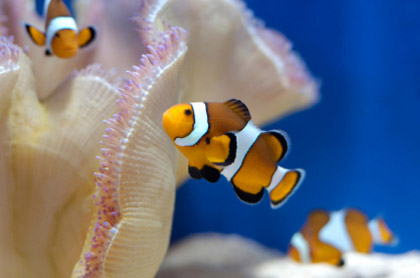Ocean Observing Systems Stimulating Interest in STEM
Ocean observing systems and ocean observatories are being developed and deployed in the U.S. and around the world to make sustained and continuous oceanographic measurements and to deliver that information in real-time to research, operational and commercial users. Many also see educational applications from data collected by ocean observing systems, including real-time data. A challenge for the educators is whether data from these systems can help generate student interest in STEM (science, technology, engineering and math) and, thus, become an important tool for training the scientific and technical workforce of tomorrow. Real-time data is potentially interesting, even exciting, to students because students will be seeing the data at the same time as scientists and everyone else. This raises the possibility that students and other learners will be active participants in the discovery process. The hope is that this potentially interesting and exciting data from the ocean systems will help stimulate interest in STEM in general and in the ocean environment in particular. For this to occur, however, educators need to package real-time and other data from observing systems in a form and context that can be readily used and interpreted by students.
Ocean observing systems are not a new concept, although using the data for educational purposes is comparatively new. The U.S. Navy has had ocean observing systems in place for military purposes for many decades. For example, development of the Navy’s Sound Surveillance System (SOSUS) for using acoustic signatures to track Russian submarines was started long ago. ARGO is an example of an international civilian ocean observing program that was started more than a decade ago. ARGO involves international ocean scientists who deploy thousands of profiling floats throughout the global ocean using commercial, oceanographic and other ships of opportunity. The floats move with ocean currents and measure temperature and salinity with depth (profiles) from the surface to 2000m, as well as the average speed of ocean currents. Each float cycles from the surface to 2000m every 10 days and each has an operational lifetime of about 4-5 years. Each float thus has the potential for measuring hundreds of profiles. When the float is at the surface it transmits its data via satellite links back to processing centers in Brest, France, or Monterey, Calif. All ARGO data are publically available in near real-time at no charge.
With more than 3,500 floats scattered throughout the global ocean, ARGO temperature, salinity and velocity data can be used to teach basic concepts like temperature patterns of the global ocean, how to read and interpret graphs and illustrate complex ocean phenomena, such as how climate change is affecting the ocean. Given the broad range of possible audiences for learning about ARGO, educators are using several different approaches: materials and lesson plans for classrooms, workshops that target the science community and online resources, such as Google Earth and Wikipedia, which provide the public (free-choice learners) the capability to study the ocean with ARGO data.

© iStockphoto.com/Pgiam
These approaches are similar to what is now being developed for other observing systems.
The U.S. is developing two new ocean observing systems and both include educational applications in their respective portfolios. The National Oceanographic and Atmospheric Administration (NOAA) is leading the development of an operational system called the “Integrated Ocean Observing System” (IOOS). The purpose of IOOS is to provide information and data to increase understanding of U.S. coastal waters so decision-makers can take action to improve safety, enhance the economy and protect the environment. The National Science Foundation’s Ocean Observatories Initiative (OOI) is constructing infrastructure to support sensors to measure physical, chemical, geological and biological variables in the ocean and seafloor to support scientific research. The total national investment in both of these systems will likely exceed $500M by 2015, and the costs to operate will likely exceed more than $50M per year. The systems are anticipated to have a major impact on ocean science research and operations.
In addition to research and operational users, educational applications for data from IOOS and OOI are being developed, including educational uses of data delivered in near real-time. As mentioned above, the challenge for educators is to package real-time data in a form and context that can be readily used and interpreted by students and their teachers. This is particularly challenging for K-12 audiences because younger students and their teachers lack experience and tools to produce analytical products, such as simple statistics and graphs from raw data streams. Putting data products into an oceanographic context is also difficult when students lack basic knowledge of the ocean environment. For example, a series of graphs showing how ocean water temperature changes with depth, and why those profiles change with season, is not very interesting in itself. Students need the context, e.g. they also need to understand something about mixing between surface and deeper waters as well as how seasonal changes in the amount of solar energy reaching surface ocean waters affects ocean mixing, and why this is important.
Younger students likely will need to work with data products produced for them by their teachers or by online educators that display data in very simple ways and then link it to a lesson plan that puts the observations into the right context (example). With the possible exception of advanced high-school students, real-time data streams from ocean observing systems are probably not for K-12 students. Nevertheless, younger students with adequate guidance can still learn about daily and seasonal changes in the ocean and why they occur by looking at a sequence of graphs produced for them. They can also learn about organisms that live in the ocean from video streams associated with ocean observatories, such as Neptune and Venus. Ocean observing data will obviously be most useful if it can be linked to national and state science standards.
The process for how K-12 students and teachers can effectively use data from observing systems, including real-time data to better train students to participate in the STEM workforce of the future, was described recently as a process involving four key steps (Hotaling 2007). Step one is the ocean observing data needs to be accessible, which means the data needs to be available, including to schools and classrooms lacking sophisticated computers and fast networks. It also needs to be understandable by non-specialists, i.e. it has to be in context of important and simply described ocean processes.

© iStockphoto.com/Tammy616
Step two is the data has to be useable, which means it must be engaging and meaningful, fit within STEM curricula and satisfy educational standards. Step three is teachers themselves must be adequately trained so they are comfortable using and discussing ocean observing data in a classroom. This requires effective professional development via online or face-to-face training or a combination thereof. Step four is the importance of preparation at the K-12 level, so students entering four-year or community colleges know something about how to apply observatory data to real-life situations. This would lead to much quicker and effective training of a well-qualified STEM workforce with the skills to manage and utilize data from sensors and sensor networks, whether associated with ocean observations or any other sensor network, including those associated with commercial operations.
A top priority for educational uses of data from NSF’s Ocean Observatories Initiative (OOI) is the focus on special tools and lessons for undergraduates. Undergraduate class projects and senior theses can obviously take better advantage of real-time and other observatory data than K-12 students given that undergrads have better skills and access to better analysis tools as well as more time to analyze and interpret longer records of observations. The expectation is that undergraduate ocean science or other science majors, non-science majors and community college students can work with real-time data, if provided the software tools to simplify data streams and to provide context. The first three steps listed above for K-12 are certainly applicable to undergraduate students and their professors, although college science professors should not need the level of professional development that K-12 teachers will require.
Data analysis tools for undergraduates, and perhaps advanced high-school students, need to be scaled to examine relations between, perhaps, just two ocean variables – temperature and salinity, for example. Furthermore, there has to be a web-based framework that puts the data into context for undergraduates. A web interface, for example, could allow an undergraduate interested in undersea earthquakes to examine the real-time record of an undersea seismometer (basically a chart showing the strength of earth movements) while at the time ingesting and then watching video illustrating different types of undersea lava flows. The most sophisticated college users, such as ocean science graduate students and ocean science faculty, will likely use commercially available data analysis packages to study relations between many data sources and from many locations.
There is, of course, a downside for students of all ages to work with real-time data collected by ocean observing systems. Often not much happens during a single session of analyzing real-time observations or even during the period of a student project. Anyone who has watched real-time video of the seafloor knows this well. Furthermore, some of the most interesting insights into ocean processes result from ocean measurements collected throughout many years. Long records will not be available from new observatories for many years to come, so initial applications will have to focus on changes in the ocean that occur every hour, perhaps due to tidal effects in the coastal ocean or to daily changes as winds strengthen and then weaken or by change of seasons at the higher latitudes.
Will such changes be sufficiently engrossing to students to keep their interest in ocean observing data? Possibly, if there is an appropriate context so students understand the oceanographic meaning of their observations. Another downside of observatory data is students are not collecting data themselves, much less building, calibrating or modifying instruments, which make measurements.

© iStockphoto.com/juuce
Many believe the hands-on activities of collecting data and understanding instruments that make that happen are just as important as data analysis and interpretation, particularly for students.
In conclusion, ocean observing systems and observatories have the potential to stimulate students since they will be seeing data at the same time as scientists and everyone else. The downside is often not much happens during a comparatively short period of time, such as a data time series observed during a typical K-12 science class. Furthermore, students and teachers are not generally involved in hands-on activities, such as building data collecting systems and sensors, deploying systems, calibrating instruments as well as all the other activities required for collecting high-quality data.
Thus, the most imaginative uses of ocean observing data for educational purposes will likely include at least some of the more hands-on activities mentioned above, but it is not obvious as to how that can be effectively done for a large population of potential student users. Engaging learners of all ages is a worthy goal for ocean observing systems, which will add value to the government investment being made to serve research and operational users. All of America will benefit if one of the outcomes of the investment is a more sophisticated STEM workforce that better understands sensors and networks and how they can be effectively used to make environmental measurements.
Acknowledgements: I thank those associated with the Centers for Ocean Sciences Education Excellence – Networked Ocean World (COSEE-NOW), especially Liesl Hotaling and Janice McDonnell, for informative discussions related to the topic of this article




























